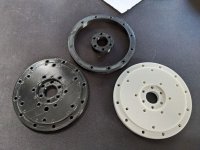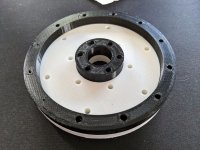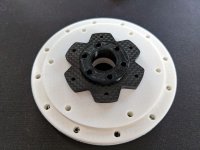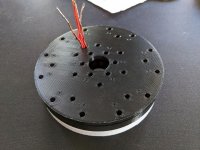HalbachHero
100 W
- Joined
- Apr 5, 2021
- Messages
- 228
I would imagine it might be conductive, but insulated from the enabled magnet wire. I am not sure it it would impact the performance or not. It's a good question.Looks great. Is carbon fiber sheet conductive?
Thanks for the pointers. I made some changes to the design again and added voids per your suggestions. The voids correspond nicely with where the wire does not lay on either side. This should allow epoxy or composite filler to easily make bond to the otherside hopefully. Another thought I had was to use some ferrous material to wind around. I found that I can get 0.4mm spring steel, which I could either use a single layer of, or use a few laminations to improve inductance. I do worry that using a ferrous material might have negative consequences due to it being a single piece, but being so thin, I'm hoping it would reach saturation easily and potentially improve the torque.It's not easy to bond new composites to already cured composites. You could cure the carbon with a peel ply or maybe find some with a surface finish ready for bonding.
You could look at using other core materials too. Balsa might work well (as long as it gets sealed.) It can also be easily laser cut.
You could also 3D print your winding ring with triangulated (or honeycomb) cutouts like a screen. You could then use that as the winding jig that then becomes a sandwich core for the composites. The holes in the ring allow the 2 sides to be connected and be much more rigid. There are different composite fillers you could use to fill those voids. This should reduce fdm print time a bunch too. The composite won't likely bond with the print but should be strong with the composite filled / connected voids.
You could also add these voids in a different core material like balsa mentioned above.
How does a 3mm X 3mm X 3mm cube magnet look in your setup? Really asking if it's worth going through the trouble for the extra .5mm for the other magnet while trying to build / glue it all up.

I am going to try to make another winding using this new version, and if it goes the way I am hoping, I am going to order some of these made from chipboard (0.8mm), and some with the spring steel (0.4mm) and see how they go.
I think I might have changed my mind on carbon fiber, at least for now, only because I can only get it in 1mm thickness thought the Send Cut Send service that I am using. And I think that makes the faulhaber winding not worth it. I think the biggest gain I can get from this winding type is the ability to get more turns into a thinner stator with less resistance. Even though there will be about a 30% reduction in torque do to the angle of the windings, I can get the rotors closer together which will increase torque, and without the end turns, I can reduce the resistance by ~30% as well. Also, getting more or the same torque from less copper means less losses at higher RPM. I think....










